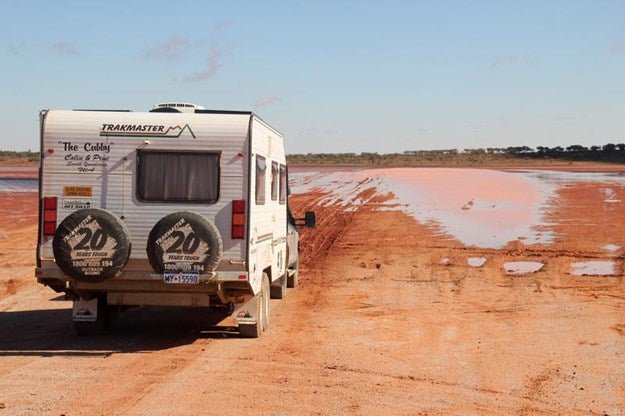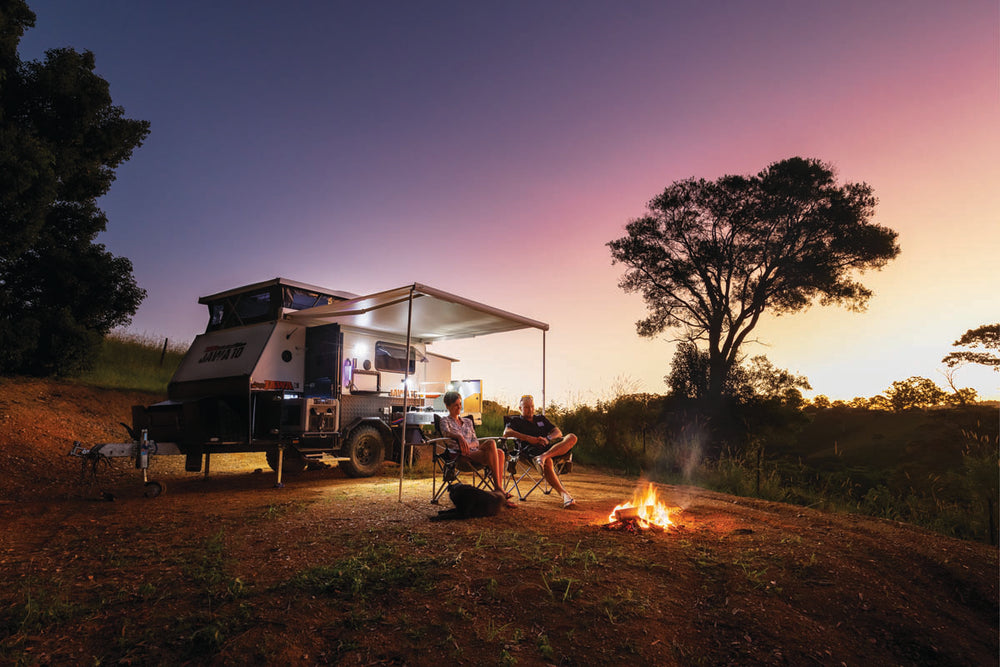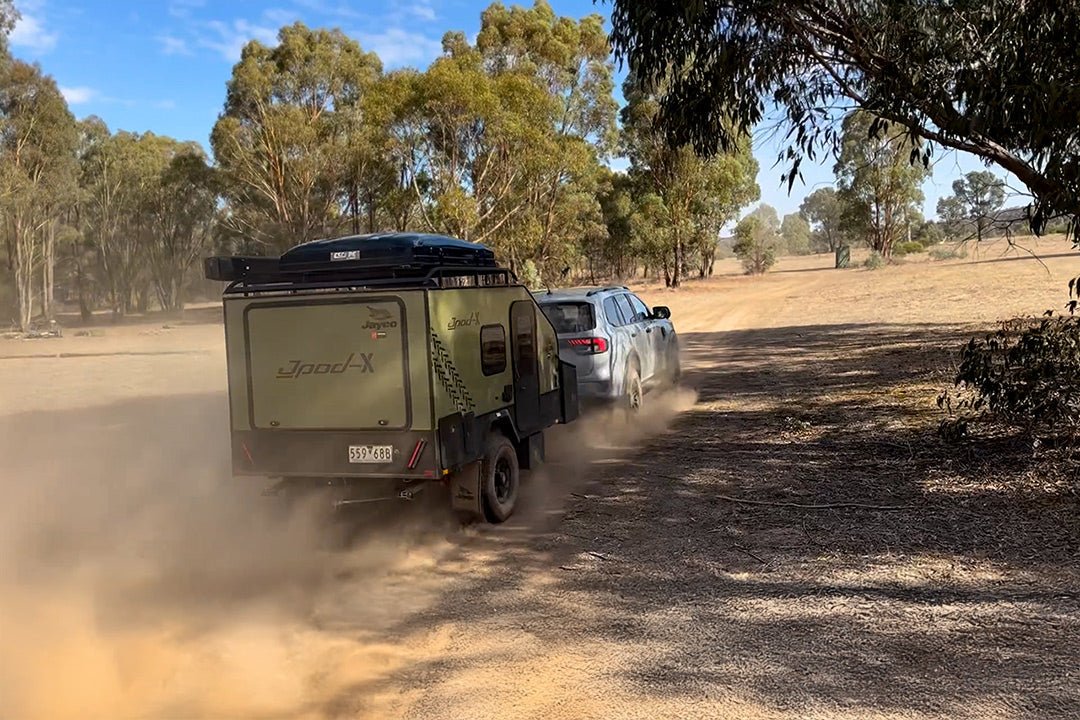Offroad Touring Prep

Many travellers these days will tell you that when the bitumen ends, the real excitement of Aussie travelling begins.
Whilst of course, there are countless great spots to see and enjoy right around the country without getting dust on your tyres, the ability of both drivers and their rigs to safely travel ‘offroad’ opens up a huge range of splendid travels to some of our lesser known, but equally as good, scenic locations and memorable outback experiences.
Heading off the blacktop however, certainly isn’t for everyone. Firstly, unless you are experienced (or willing to gradually build up your ability to handle offroad conditions), driving out there can put you well outside your comfort zone and will likely add a degree of stress to your travels. This can not only take away some of the joy of travelling, but can also turn out to be quite dangerous.
The other main consideration as to whether you head offroad, is the ability of your rig to handle such travelling conditions without either structural damage or, more likely, minor incidents which can sometimes be quite numerous. This includes internal caravan hinges, drawers, doors or other components coming loose, falling off, or even windows, TV aerials, air-conditioners, etc. vibrating loose (or off) on some of the rough, corrugated roads you’ll encounter once you leave the bitumen.
These days there are a variety of touring rigs (caravans, camper trailers, campervans, etc) which are classified as ‘on road’, ‘semi offroad’, ‘dirt road’, ‘fully offroad’ or any number of other tags or labels which indicate their different degrees of capabilities in offroad conditions.
Once you have assessed your ability and that of your rig to head offroad, the first and best bit of advice is to drive to the conditions, and not to a timetable!
If you take it easy, a few kilometres on good gravel roads or even bypasses around highway roadworks should not be a problem for any RV unit, but once you head more extensively into off-the-beaten-track conditions, there are a number of things to keep in mind to help you and your rig to reach your destination in relative comfort and safety.
CONSIDER YOUR TYRES
All-terrain or light truck tyres are the go for most offroad conditions. Normal highway tyres are simply not suitable for these quite harsh tracks and will sooner or later cause trouble in the form of a puncture or a blowout.
Depending on the state of the road, the roughness of the gravel, depth of potholes, as well as bull dust and corrugations, it is generally advisable to lower the tyre pressures in both your tow vehicle and your caravan. This not only makes for a more comfortable ride all round, but it also cuts down the likelihood of tyre damage (even with offroad tyres) from sharp rocks.
Other than on smooth, well-graded gravel roads, you should start by reducing tyre pressures by around 25 per cent from normal highway levels and be prepared to come down another 5-10 per cent if conditions dictate (such as rocks and corrugations) — and quite a bit further in sandy conditions.
Remember to reinflate them when back to highway conditions once you are back on the blacktop. For offroad travel it is advisable to carry a compressor — either a portable model or one that is built into your vehicle. Talk to your local 4WD shop or mechanic about these options.
TRAVEL SPEEDS
In offroad conditions the grip your tyres have on the road is significantly reduced, as is your ability to control your rig over these varying surfaces. Driving to the conditions on gravel/earth-formed roads or tracks might mean 20-30-40km/h at times or perhaps 60-70km/h on relatively better sections, but even on good gravel, never more than 80km/h.
Yes, some people do drive at even higher speeds, but particularly in larger rigs towing campers/caravans, you will be compromising your safety and that of your passengers and rigs to do so … and after all, you’re out here to enjoy yourselves, not set speed records!
CORRUGATIONS
These are the real curse of outback travel … and they can vary quite significantly in size, shape and severity. Where conditions allow (with few rocks, potholes, corners, etc) it is generally better to build up your speed and try to roll over the top of corrugations. Here we’re talking about 50-60-70km/h — as always, however it is a mixture of safety, control and comfort.
DON’T FORGET THE DUST
Out here, dust is a part of life, so basically you have to get used to it! If your caravan is fitted with a scupper vent, open it and use it to pressurise your van. This usually helps, but will never completely eliminate dust from getting inside.
Some dust around/in cupboards, etc, will often show you where some extra sealant may be needed, either during or at the end of your trip. When driving on gravel roads, ensure you keep well back and out of the dust of others travelling in the same direction as you are — it’s better for vision, safety and also reduces the amount of dust going into your vehicle’s air filter.
When oncoming vehicles are kicking up dust, slow down, keep well over to the left, and perhaps even stop if you can’t see ahead. And have your headlights on — this helps you to be seen by any other vehicles which might be following the first one in its dust.
ROAD CONDITIONS
In most offroad situations, it is usually advisable to get an up-to-date report on the condition of the road/s on which you plan to travel (especially after rain). You can use information centres in townships, the local garage, fellow travellers or the police. It is always better to know things beforehand in case alternative routes or other travel plans need to be considered.
WET ROAD CONDITIONS
After rain, many outback roads can dramatically change character. They can quickly become slippery, muddy, boggy or closed altogether. Never go through or past a ‘Road Closed’ sign — it is there for a very logical purpose and should not be ignored. Heavy fines also apply.
In wet conditions, travel much slower than normal to ensure you keep control. When driving through water, it’s best to stick to the centre of the road where, because of continued traffic, it is more likely to be solid underfoot than out on the edges. Do not drive through water unless you are entirely sure you can negotiate it without difficulty — and here we are not talking about deep water crossings where you must be experienced to handle such conditions.
WEIGHTS AND LOADS
Overloading is often a real concern with RVs (of any sort) with the overriding advice to try to lighten your load and only take what you need, especially with heavy food and other supplies. Plan to shop along the way and not carry everything with you from home. The more weight you are carrying means the more strain you create on both your caravan and tow vehicle. And always ensure you keep within your RV/caravan weight limits.
Also bear in mind that in offroad conditions, any weight distribution bars on your caravan should be removed. Here, over undulating roads and creek beds, these bars can create huge forces on your tow hitch/van and tow vehicle which can be quite dangerous and damaging. And, with your lesser speeds in offroad conditions, they are much less essential.
AUSTRALIAN WILDLIFE
Wandering stock and wildlife are regularly seen in offroad areas and are generally less used to encountering traffic compared to those found beside or on sealed roads. Always slow down and ensure that the animals are not about to panic and race out in front of you.
Eagles and other birds feeding on ‘roadkill’ are sometimes quite reluctant to move away from their meal, so reduce your speed as the bigger birds can often be slow and cumbersome when or if they take off.
It is very important that you do not swerve to try to avoid hitting an animal. Swerving is the main reason that drivers lose control and end up crashing. Always maintain your line when braking and realise that in most circumstances if you do hit an animal, less vehicle and human damage will occur compared to crashing/overturning on the side of the road.
Fitting a roo/bullbar should also be considered if you are planning a lot of outback travel, and in any case try to avoid travelling at dusk, dawn or at night when visibility is poorest and animals are often out and about.
Also consider fitting stick-on sonic animal guards to the front of your vehicle. These devices, which cost $6-$8 a pair, emit an ultrasonic noise as air flows through them and are heard by animals and act as a warning.
COMMUNICATION
As many travellers already know, mobile telephone/internet service around the country varies widely outside major towns and cities and, in offroad regions, you often leave these services miles behind. In these conditions, particularly in more remote areas, it is advisable to carry a satellite phone or HF radio, or even one of these ‘Spot’ devices which (via satellite communication) can get a message out in the event of an emergency.
Travelling with another vehicle (in case of breakdown/help needed) is also advisable where that can be arranged. As a last resort in a life and death situation, an EPIRB is a handy option in your outback travel kit.
OTHER SAFETY GEAR
Offroad travel often involves a degree of risk that you may get bogged, breakdown, need to be towed, etc. and depending on the degree of isolation, such basic safety gear as a tow rope, snatch strap, MAXTRAX (or similar sand bog planks), spare fan belt and two spare tyres should be carried.
Remember, if you break down, always stay with your vehicle where you have water, shelter and food.
You’re more likely to be spotted from the air and then rescued than wandering off and walking in vain looking for help.
FUEL SUPPLIES
In remote areas it is always a good idea to ‘top up’ with fuel along the way instead of saying to yourself that you should be able to make it to the next (eg cheaper) fuel stop further up the track.
If there is a closed road or other reason to deviate your course then you will, with confidence, still have enough fuel to handle it. The alternative here is to carry extra emergency fuel with you in jerry cans.
ENOUGH WATER?
A golden rule is to always carry plenty of drinking water. As well as what you have in your RV built-in tank/s, get into the habit of carrying some emergency water in one or two other containers (ideally 10L or 20L). This then helps in an emergency situation should a stone (or something else) penetrate your RV’s water tank — this way you will still have some water to carry on.
TRAVELLING WITH PETS
In rural and outback areas, local shires and property owners often have a real problem with feral animals (wild dogs, foxes, rabbits and cats) and use poison baits such as 1080 quite extensively across these regions to try to control them.
All pets travelling with you must be strictly supervised and usually always on leash so that they don’t wander off and pick up a deadly bait. You are a long way from veterinary help out here!
GRIDS AND GATES
Also found in rural areas are cattle grids and gates separating one property or one paddock from another. The rule with gates is to follow any sign, eg “close the gate” or otherwise leave gates as you find them — either open or closed!
Grids, of course, stop any animals from crossing but allow easy travel across these boundaries for motor vehicles.
Most grids are built up with gravel either side making them quite smooth to travel across, but beware that in some cases the soil on the approach has been washed away leaving grids somewhat elevated and very rough to cross. This could cause vehicle damage if taken too fast. Always take them slowly and carefully.
CAMPING ETIQUETTE
In offroad situations there are usually many free camping options, either in designated rest areas or more usually just a pull-in bush site along the way. It’s important that you leave no trace of your visit and take all rubbish away with you. If you come across evidence of other campers’ mess (where practical) clean that up too and leave the site even better than you found it.
Remember that you are generally heading offroad to get to some great scenic places, or perhaps to take in some appealing outback experiences or events along the way. Travel safely, take your time and bring back plenty of photos and great memories of your offroad adventures.







